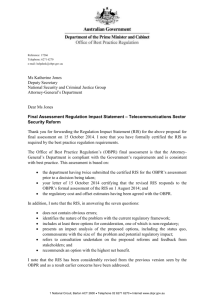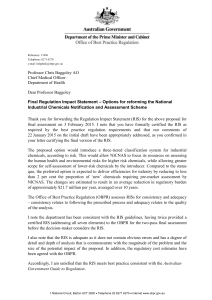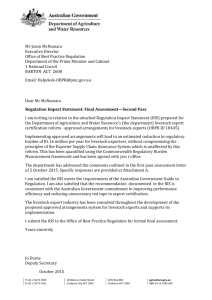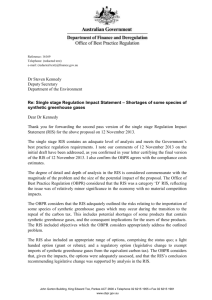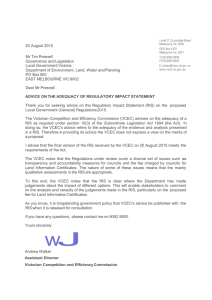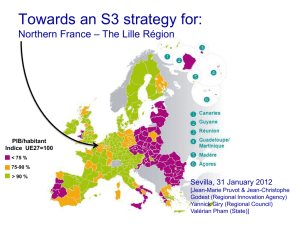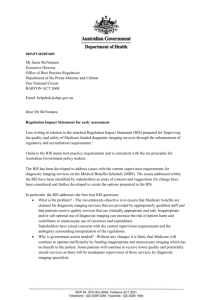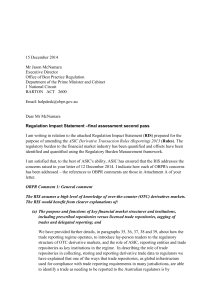Attachment: Response to 24 January OBPR concerns
advertisement
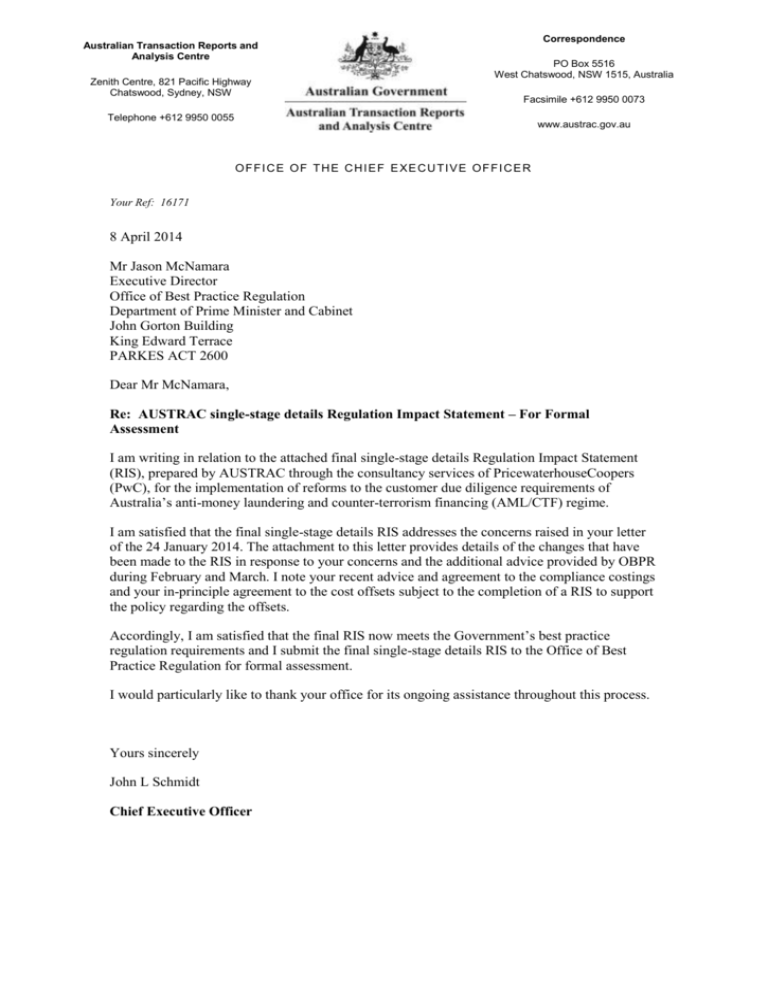
Australian Transaction Reports and Analysis Centre Zenith Centre, 821 Pacific Highway Chatswood, Sydney, NSW Correspondence PO Box 5516 West Chatswood, NSW 1515, Australia Facsimile +612 9950 0073 Telephone +612 9950 0055 www.austrac.gov.au O F F I C E O F T H E C H I E F E XE C U TI V E O F F I C E R Your Ref: 16171 8 April 2014 Mr Jason McNamara Executive Director Office of Best Practice Regulation Department of Prime Minister and Cabinet John Gorton Building King Edward Terrace PARKES ACT 2600 Dear Mr McNamara, Re: AUSTRAC single-stage details Regulation Impact Statement – For Formal Assessment I am writing in relation to the attached final single-stage details Regulation Impact Statement (RIS), prepared by AUSTRAC through the consultancy services of PricewaterhouseCoopers (PwC), for the implementation of reforms to the customer due diligence requirements of Australia’s anti-money laundering and counter-terrorism financing (AML/CTF) regime. I am satisfied that the final single-stage details RIS addresses the concerns raised in your letter of the 24 January 2014. The attachment to this letter provides details of the changes that have been made to the RIS in response to your concerns and the additional advice provided by OBPR during February and March. I note your recent advice and agreement to the compliance costings and your in-principle agreement to the cost offsets subject to the completion of a RIS to support the policy regarding the offsets. Accordingly, I am satisfied that the final RIS now meets the Government’s best practice regulation requirements and I submit the final single-stage details RIS to the Office of Best Practice Regulation for formal assessment. I would particularly like to thank your office for its ongoing assistance throughout this process. Yours sincerely John L Schmidt Chief Executive Officer Attachment: Response to 24 January OBPR concerns The tables below provides a summary description of the concerns raised by OBPR in its letter of 24 January 2014 and detail of the changes made to the RIS by AUSTRAC to address those concerns. For ease of reference, the numbering in the responses below reflects numbering in the letter of 24 January 2014. RIS format Number Details OBPR advice – set out the reasons for the election of a single-stage RIS. • The RIS has been updated in section 1 to articulate the reasons behind AUSTRAC’s decision to generate a single-stage RIS. As outlined in section 1 of the RIS, the urgent nature of the proposed reforms, the deadlines under which Australia is operating and the significant contribution from existing stakeholder consultations were key considerations in this regard. OBPR suggestion – move background material to attachments or appendices to assist the reader to navigate the document. • All efforts have been made to enhance the readability of the RIS by moving background information and supporting documentation into appendices. The explanation of the problems being addressed by this reform, and the estimated impacts associated with the reform, have also been refined to assist in improving clarity across the entire RIS. General comments Number 1. Details OBPR concern – the analysis in the RIS relies heavily upon the FATF standards rather than the social or other harm arising from the specific conduct that the standards are intended to address. • To ensure a comprehensive assessment is given to the full range of factors which underlie this proposal, section 2 of the RIS (identified problems) has been expanded to more fully explore the underlying criminal justice, national security and revenue protection threats, and their associated harms to the Australian community. • A direct link can be drawn between the existing deficiencies in Australia’s AML/CTF regime and threats to Australian businesses and the wider community from transnational organised crime, money laundering, terrorism financing and tax evasion. These threats can be mitigated through the implementation of the internationally endorsed FATF AML/CTF standards. Problem Number 2. Details OBPR concern – the RIS must include the nature and scale of the problem as well as any risks involved and the likely consequences, as applicable, on the Australian economy, industry, businesses, the not-for-profit sector and consumers, if the Government chooses not to act. • 3. a) OBPR concern – the problem section does not provide the reader with an understanding of the nature of the problem. What are the specific problems to be addressed by regulatory action or benefit from the FATF standard for Australia. • 3. b) As noted above, significant effort has been made to more clearly define the nature and scale of the problem which has necessitated the reforms. Whilst acknowledging the challenges of presenting data on these types of misconduct, which are inherently clandestine in nature, the RIS provides examples and descriptors of the likely consequences and impacts on Australia’s national security, revenue base and financial integrity if the current regulatory regime is not strengthened by this reform. A new summary table (table 1) has been included in section 2 of the RIS to illustrate problems which have been experienced in Australia as a consequence of the existing regulatory deficiencies. OBPR concern – the RIS should undertake a balanced risk assessment of the likelihood of being removed from the equivalence list together with procedures that would attend such a decision to remove Australia. • In section 2 of the RIS more detail has been provided concerning both the nature of international measures, and the likelihood of such measures being applied, should Australia not address the deficiencies in its AML/CTF regime. Because of the speculative nature of such metrics, an estimation was not possible of the potential cost impacts of such measures on Australia. Having said this, the RIS outlines the experience of New Zealand which, because of its failure to implement the FATF AML/CTF standards, was removed from the European Union equivalence list. The RIS also notes the subsequent steps taken by the New Zealand government to rectify its AML/CTF deficiencies which then led to their reinstatement on the EU equivalence list. Number 3. c) 4. Details OBPR concerns – the RIS gives a number of examples of gaps in the existing regulatory regime and would benefit from an indication of the prevalence of these kinds of breaches. • Table 1, which has been included in Section 2 of the RIS, provides, where available, statistical information in relation to examples of criminal misconduct associated with existing regulatory gaps and, where data is not available, qualitative information in relation to the prevalence of concerns associated with the regulatory gap. • In addition, domestic and international data has been included to provide indications of the aggregate value of money laundering, tax evasion and associated activities experienced by Australia as it relates to the regulatory gaps. As previously noted, due to the clandestine nature of such misconduct, in most instances this data is drawn from informed estimates. Having said this, hard data from AUSTRAC’s financial intelligence holdings, together with data from our law enforcement and revenue partner agencies, provides a solid basis for considering the benefits to be gained from implementing these reforms compared to the cost of complying with the new regulatory requirements. OBPR concern – the RIS requires a more precise discussion of the specific forms of misconduct. • 5. Section 2 of the RIS has been expanded to describe in greater detail the threat arising from the misuse by organised crime of everyday legal entity structures (particularly companies and trusts) to conceal illegal activity. Additional information has also been included regarding the abuse, internationally, of corporate structures to conceal an estimated $56.4 billion in proceeds of crime from grand corruption cases investigated in the last two decades. The enormity of such criminal activity provides compelling evidence of the detriment which can arise if the true beneficial owners of legal entities cannot be identified. OBPR concern – the RIS should also identify the specific risks associated with the lack of transparency in beneficial ownership structures. • The responses outlined against OBPR concerns 2 - 4 above detail additional information included in section 2 of the RIS which also extends to qualitative information associated with the risks of the misuse of corporate structures. Number 6. Details OBPR concern – the RIS would benefit from greater precision when referencing certain market failures, such as ‘information asymmetry’ and ‘negative externalities’ • 7. The revision to section 2 of the RIS, the addition of examples in table 1 and the increased use of qualitative information provide a more precise description of market failures related to the problems outlined. By way of example, additional information has been included regarding the correlation between underlying misconduct associated with organised crime, the related regulatory gaps and the flow on impacts on the broader community. OBPR concern – further related to market failures, the example on ‘information asymmetry’ does not make clear how the conduct (the use of nominee accounts to disguise beneficial ownership) harms the business that facilitates the financial activity. • As noted above, the revision to section 2 provides additional detail of examples of misconduct and the resulting inadequate supply or even existence of information which would support enforcement action and revenue protection. In the context of the impact / benefits analysis for business, section 5 has been revised to provide additional detail against four broad categories – reputation, litigation, compliance and social / economic impacts. Objectives Number 8. Details OBPR concern – the RIS is an objective analysis and should contain neither bias nor pre-justify a preferred solution. • 9. Section 3 of the RIS, the objectives of government action, has been revised and is now a broad statement of the aims to be achieved by any government action. OBPR concern – as drafted, emphasised that the objective could be achieved by changes to rules. • As noted above, the revision to section 3 of the RIS has removed any reference to specific options. Number 10. Details OBPR concern – appropriate weight should be given to protection of Australia’s revenue base together with certain market transparency objectives. • The revision to section 3 of the RIS now includes, as an objective of government action, the protection of Australia’s revenue base and market transparency, which are specific problems outlined in section 2. Impact Analysis Number 11. 12. Details OBPR concern – the RIS should contain analysis of each of the options • Section 5 of the RIS, the impact analysis, has been expanded to include the costs and benefits associated with each of the three options being considered. Additional information and tables have been included in the body of the text and as appendices to provide distributional analysis of costs across stakeholder groups impacted by the reforms. • The additional information, particularly as it relates to regulatory change, includes qualitative information in relation to the significance of areas of reform, highlights business categories most affected by each area of reform and the nature of the reform (i.e. whether it is a new or existing requirement). See section 5.3 – table 4. OBPR concern – the discussion of the status quo would benefit from a more balanced assessment of the benefits associated with a risk-based and flexible approach to AML/CTF under the current arrangements. • The analysis in relation to the option to “retain the current approach” has been expanded to include more discussion in relation to the operation of the existing AML/CTF regime. Appendix A provides detail in relation to the current regulatory arrangements in relation to AML/CTF and in relation to existing customer due diligence requirements. • The assessment of the benefits of the status quo approach has been compared with the benefits of the other two options which would also be underpinned by the risk based and flexible approach of the AML/CTF regime. Number 13. Details OBPR concern – the analysis of the compliance cost that would result from regulatory change should include an indication of the practical steps that a reporting entity will need to take in order to comply with the proposed changes. • 14. OBPR concern – the RIS should consider whether it is expected that reporting entities would be in a position to meet the requirements and any systemic changes to existing practices. • 15. As noted in responses to points 11 and 13 above, table 4 in section 5 provides information in relation to the likely options that may be considered by businesses, the significance of the impact of the change and whether requirements are new or changes to existing requirements. OBPR concern – the impact analysis is somewhat counter-intuitive and needs to provide further detail between existing arrangements, problems in those arrangements and any diversionary effects of regulatory change. • 16. The assessment of the impact of regulatory change has been augmented to include a table which details, with as much precision as possible given the heterogeneous nature of affected businesses, the steps that reporting entities may take in order to comply with the proposed changes. AUSTRAC considers that revisions to sections 2 (problem) and section 5 (impact analysis) now provide a more direct correlation between the nature, prevalence and risks associated with the problems with the impact and benefit analysis for businesses, government and society. OBPR concern – greater balance is required in the discussion of the welfare impacts on society. • The RIS in section 5 discusses in more detail the benefits of these reforms to, and impacts on, society and expressly notes the possible passing on of costs by business. • The RIS in section 8 details two compliance offsets which will also provide both direct and indirect benefits to society. Consultation Number 17. 18. Details OBPR advice – the RIS must contain a completed consultation checklist and specific statements confirming the status of an options-stage RIS. [This advice was updated by advice from OBPR on the 31 March that the checklist was no longer required although it was considered best practice to include information on the policy-development process to date.] • Based upon recent advice, the consultation checklist has been omitted. • Section 3 of the RIS has been updated to include several paragraphs detailing decisions and actions taken to date to support the objectives of the government action. OBPR concern – the consultation requires a more balanced discussion of the views expressed by stakeholders including analysis of views expressed by stakeholders who do not support the proposed changes together with stakeholder views on compliance costs and how these views have informed the cost estimates. • Section 6 has been comprehensively updated to reflect the additional engagement, both public and targeted, that AUSTRAC has conducted between January and April 2014. A more comprehensive account of the views expressed by stakeholders in relation to both the reforms and the impact costs has been included together with analysis of those views and how they have informed the policy and costing development. • AUSTRAC acknowledges the significant benefit that has been derived through the consultation, which first commenced in April 2012 regarding these reforms. Costs and offsets Number 19. Details OBPR concern – the RIS must quantify the regulatory burden to business, community, organisations and/or individuals of new regulations and detail all key assumptions associated with the cost estimates. • The RIS has been substantially re-worked to detail the methodology of the approach to the impact cost, the distribution analysis and detailed assumptions that have been considered to develop the costs. This information is contained in sections 5, 6, 8 and appendices b, c, d and e. Number 20. Details OBPR advice – the quantification of costs must be derived using the Australian Government Business Cost Calculator and must depict the costs and offsets in the form provided. • The executive summary to the RIS includes the new cost estimate table. • The Australian Government Business Cost Calculator was used to derive the costs. Conclusion Number 21. Details OBPR concern – the conclusion should be revised to reflect changes made to the problem section. • AUSTRAC considers the expanded analysis included throughout the RIS now provides for a more logical and informed conclusion. Implementation and Review Number 22. Details OBPR concern – the RIS should outline planned timelines and review processes or mechanisms. • Section 7 of the RIS has been updated to include information on the implementation timeline and includes details of review mechanisms that are ongoing in relation to Australia’s AML/CTF regime.
